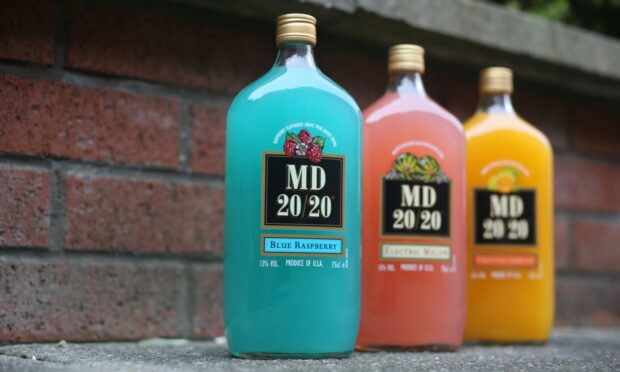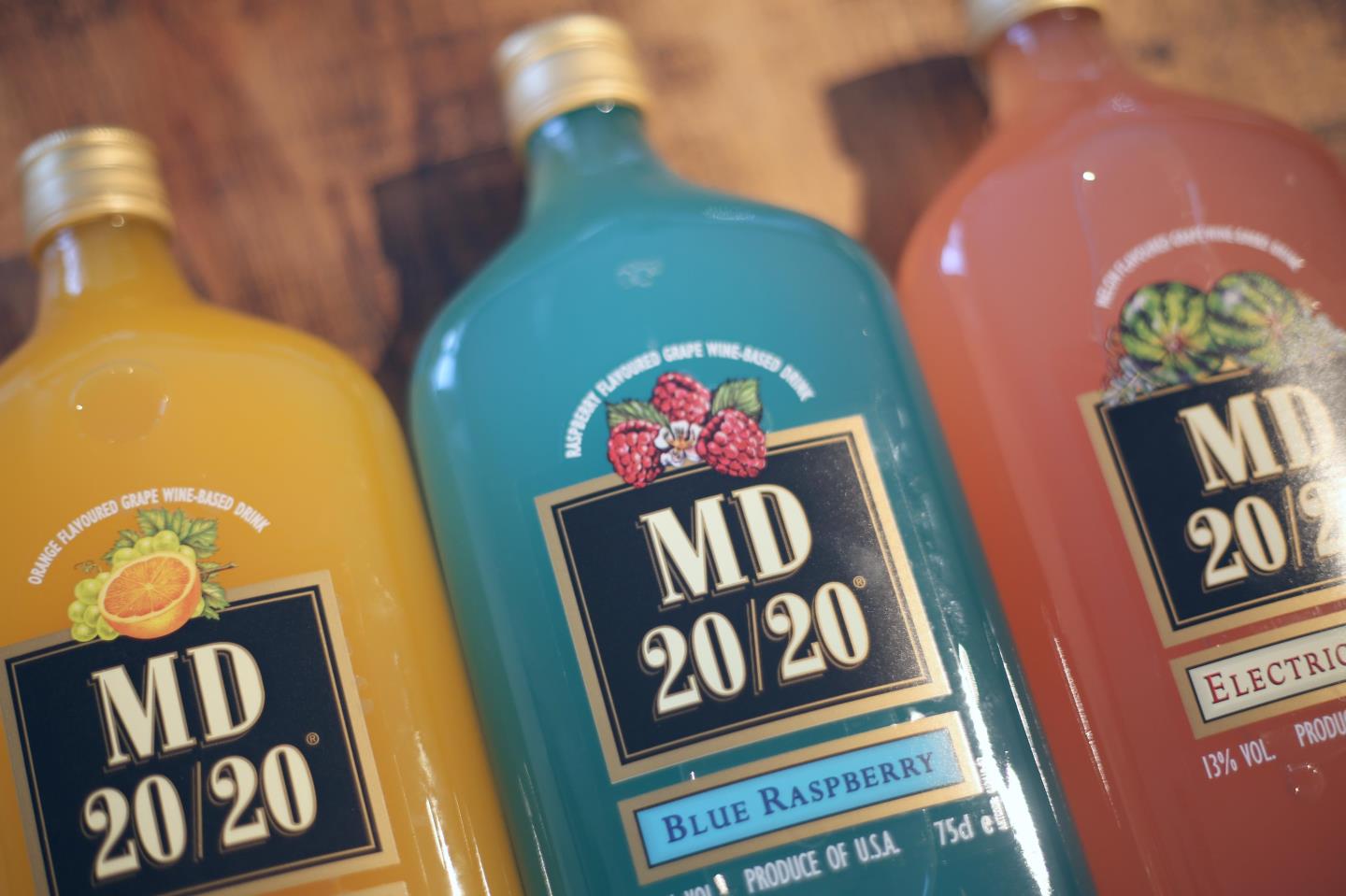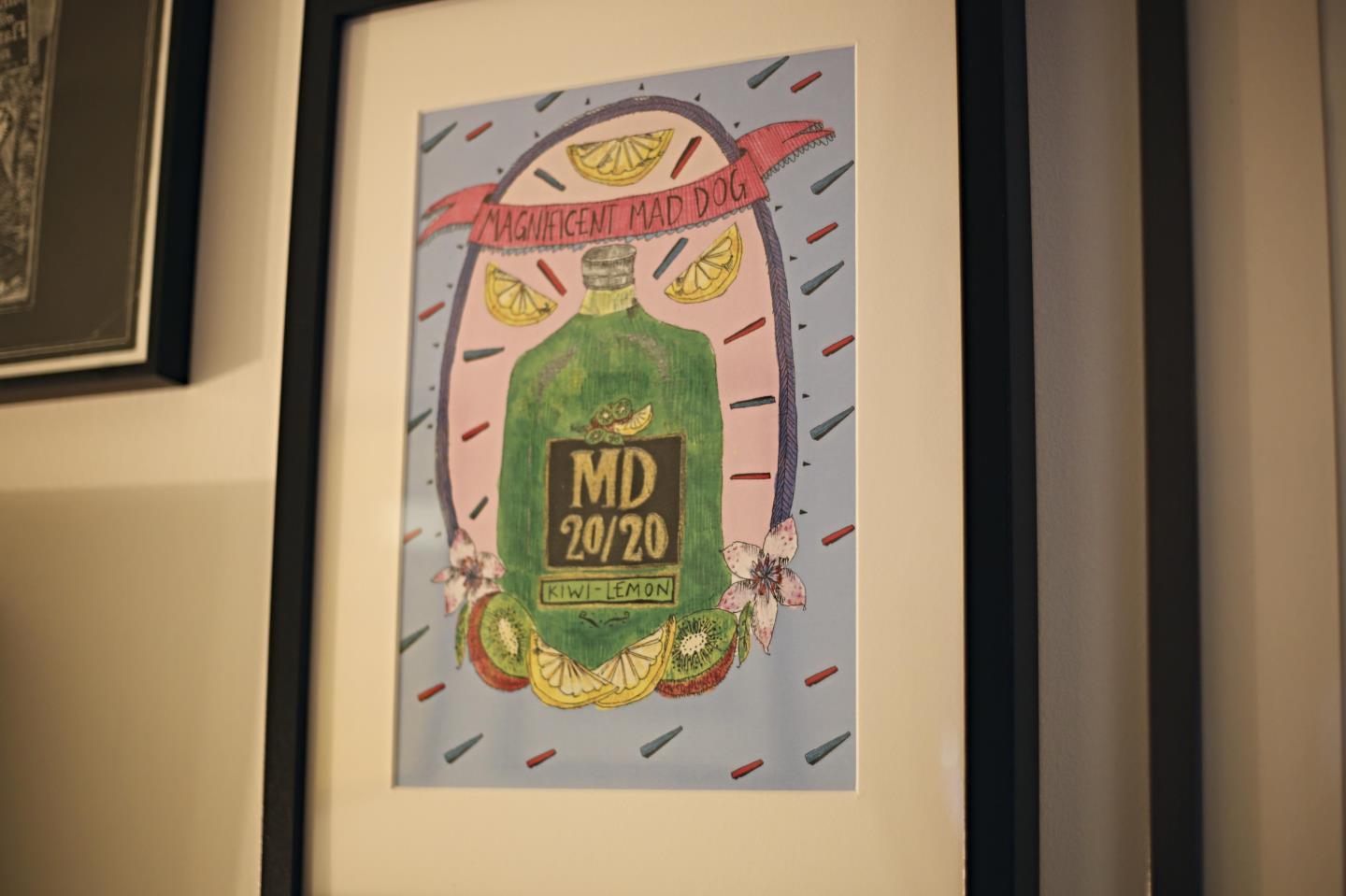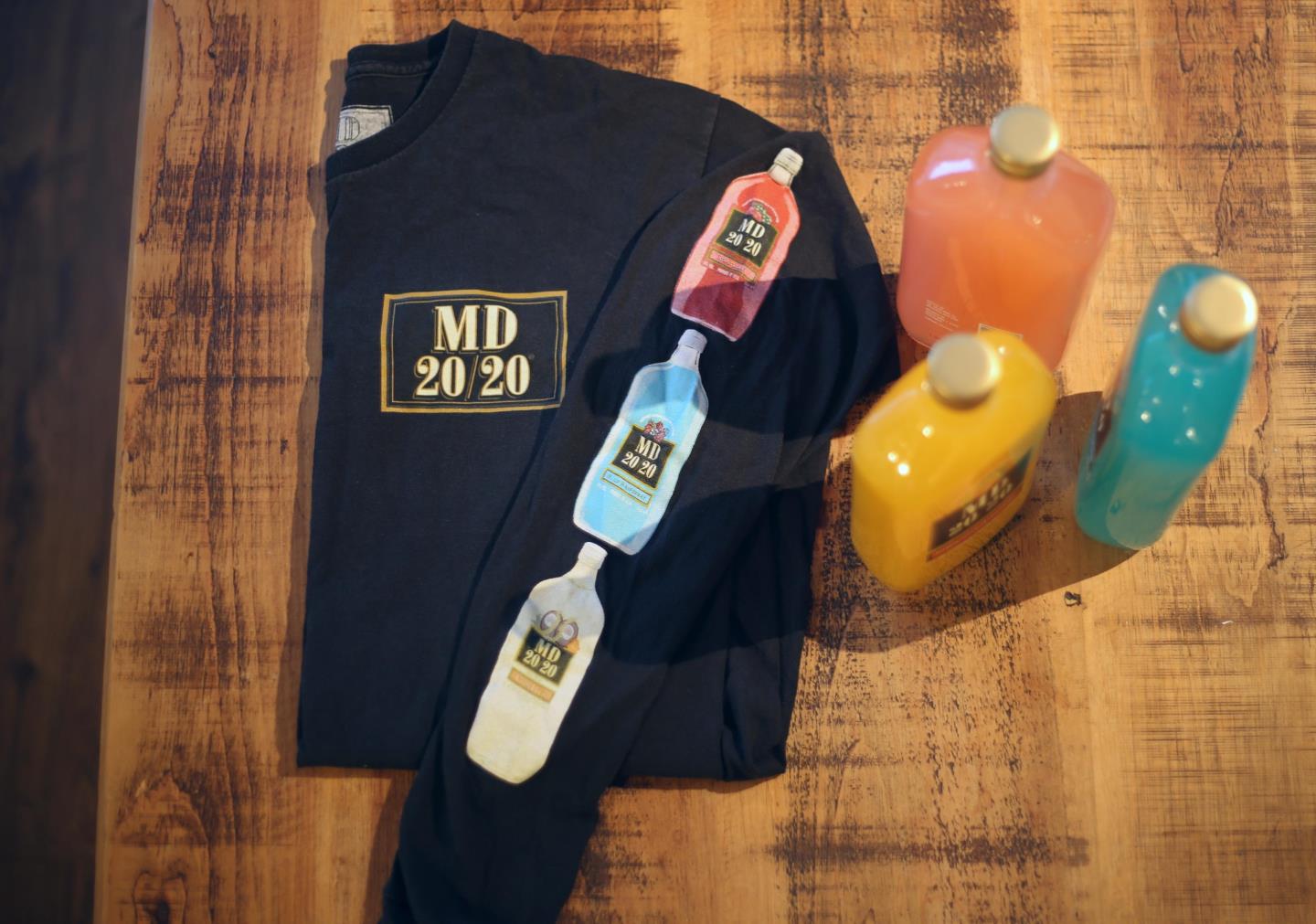American food and drink writer Will Gordon is thrilled to learn that, in 2022, Scotland is still drinking MD 20/20.
Nicknamed “Mad Dog”, MD 20/20 is Scotland’s second favourite tonic wine. It’s sold in chunky, 750ml-sized, cuboid-shaped bottles with rounded edges and screw tops, and comes in as many as nine or 10 brightly coloured shades.
Flavour names range from the straightforward (Strawberry-Kiwi and Dragonfruit) to the perplexing (Electric Melon and Banana Red).
The fact that the tonic wine more famously associated with Scotland, Buckfast, was originally produced by monks in an abbey in Devon often prompts a smile, but MD has its own surprising backstory.
There’s a strange veil of mystery surrounding when exactly MD 20/20 was first bottled and sold, but by 1972 it accounted for 50% of Mogen David’s total sales
“MD” stands not for Mad Dog, but for Mogen David: the name of a wine company founded in Chicago in 1933. The business became known for making kosher wine, intended to be drunk at Jewish religious celebrations.
To make it, they used sweet concord grapes that are most commonly the base of jam and soft drinks. And, as Scotland knows all too well, sweet sells.
Fairly quickly, the product became popular outside of the Jewish community and all across the United States. Then, in 1957, competitor Gallo launched a low cost, high alcohol white tonic wine called Thunderbird and knocked Mogen David down a peg or two.
“Enter MD 20/20, so-named because it was 20% alcohol and came in 20-ounce bottles,” writes Bryan Dent for Brutal Hammer, “No source that I have found […] can say exactly when it appeared or how it was received. Mad Dog just showed up.”
MD 20/20 comes to Scotland
There really is a strange veil of mystery surrounding when exactly MD 20/20 was first bottled and sold, but by 1972 it accounted for 50% of Mogen David’s total sales.
We know this because, in February 1979, then-Federal Trade Commissioner, Paul Rand Dixon, wrote about it in a comment piece published in The Washington Post.
The product weaved its way into US pop culture quickly. Everyone from Tom Waits (in 1977) to Elliott Smith (in 1994) namechecked MD 20/20 in songs.
By 1998, a reported 1.5 million adults drank Mogen David products. Though it’s difficult to determine exactly when the exporting of MD 20/20 to the UK began, by the mid-1990s, Scotland had adopted Mad Dog as its own. Or a certain, not-quite-legally-pub-going age group had, at least.
In 1997, the University of Strathclyde published a study titled “Young people, alcohol, and designer drinks” that interviewed 824 12 to 17-year-olds from the Argyll and Clyde Health Board area. No points for guessing which “designer drink” seemed especially, concerningly popular with that young demographic.
Even in the early 1970s, Paul Rand Dixon suggested that MD 20/20 was best suited to “the youthful drinker”. A real wine connoisseur wouldn’t drink it if they were paid, he concluded.
Drink writer Jason Wilson includes the tonic wine on his personal list of “suburban New Jersey public school rites of passage”.
Just a few states over, in the suburbs of Massachusetts, a teenaged Will Gordon – a self-confessed “guy who drank the blue one” – was showing up to nineties house parties, Mad Dog in hand. He had no idea that kids just like him were doing the very same thing at the very same time, 5,000 miles away in Scotland.
“I think it was considered a little wild or a little more edgy than just stealing your dad’s beer or something,” says Will.
“And just, honestly, the portability. It’s just a little easier to carry around than a bunch of beer or a bunch of cans of cider or something. So it was conducive to sneaking around.”
Scotland’s scientific research backs this up; more than half of the young participants of Strathclyde’s 1997 study said they chose MD 20/20 over competitor products because it was “easy to drink outside”.
Far stronger than an alcopop
The paradox at the crux of MD 20/20’s longevity in Scotland is that, in part, it almost certainly remains popular today because of its bad reputation.
Buckfast earned the nickname “Wreck the Hoose Juice” because its high alcohol, caffeine and sugar content prompted turbulent behaviour in drinkers. Really, MD is no different.
A standard 750ml bottle of MD 20/20 contains 10.5 units of alcohol. A 275ml alcopop has just 1.5
When the mid-1990s era of the alcopop dawned, Mad Dog was often lumped in with the likes of Hooch and Reef, despite MD’s much higher ABV. It may no longer measure in at 20%, but the modern recipe isn’t far behind, at 13% (Buckfast is 15%).
An NHS Greater Glasgow & Clyde information pamphlet warns young drinkers that a standard 750ml bottle of MD 20/20 contains 10.5 units of alcohol. A 275ml alcopop has just 1.5. Don’t let the neon colours and fruity flavours fool you: MD 20/20 is a seriously alcoholic beverage.
As problematic as the relationship continues to be, Scotland has always liked a drink – the stronger the better – even when there wasn’t necessarily money to pay for it.
“If you look back to the 1920s and 1930s, a very popular drink amongst lower income groups in urban Scotland was something called ‘red biddy’,” explains writer and whisky industry stalwart, Nick Morgan.
“Red biddy was red wine and methylated spirits. It was an illegal product – there weren’t red biddy brands – but it was readily available, and was considered to be a real problem.
“The other thing that was quite big was the process of what’s called ‘grogging’ in whisky, which is when you put water into a cask that’s been emptied and, roughly speaking, shake it around, then pour out a weak, alcoholic liquid and drink it.
“So, there’s always been this tradition of very poor quality alcoholic products being consumed by people on very low incomes.”
MD 20/20 has fallen out of favour in the US
According to Paul Rand Dixon’s op-ed, a large retailer in the 1970s reported that the non-Jewish buyers of Mogen David drinks were generally not wealthy. MD 20/20 is often referred to as “bum wine” in the US, as it was once commonly drunk by homeless people.
Mad Dog may have been affordable for underagers chasing thrills in the 1990s (in Will’s day it cost $3), but now a bottle will set you back between £8 and £10. If you could find it in an American liquor store, it would be cheaper: about $5 to $7 (between £3.50 and £5). But that “if” is a big one.
Urban Outfitters in Brooklyn sells MD 20/20 T-shirts, but there’s no trace of the drink itself across New York City
Even though this Scottish corner shop staple is still made and bottled in upstate New York, today you’ll struggle to source it there, or anywhere in the United States.
Urban Outfitters in New York’s Brooklyn borough sells “retro” T-shirts, sleeves emblazoned with brightly coloured MD 20/20 bottles, but there’s no trace of the drink itself across the entire city. Like Will Gordon, locals remember it from hazy house parties past, though they haven’t encountered the brand in years.
Whether it’s down to more liberal marijuana laws or simply changing fashions (Will says college kids these days seem to prefer drinking hard seltzer), MD 20/20 has fallen out of favour in the US. It’s not that it’s gathering dust on the shelves – it isn’t even stocked anymore.
Meanwhile, in Scotland, off-licences are filling their windows with bottles of Mad Dog; new flavours for a new generation. A special, limited edition flavour (pineapple) was released for 2020, before anyone knew what a hellish year that would turn out to be.
It proved so popular that it became permanent addition to MD’s core range. Obviously someone was buying it.
And if it’s not America keeping its own 50-odd-year-old product going, can it really be tiny wee Scotland?
Why has Mad Dog’s popularity persevered in Scotland?
Californian giant The Wine Group (which now owns the MD 20/20 brand) are tricky to pin down and did not respond to several requests for information about their exports to Scotland.
Comparing liquor store experiences in both countries, though, it appears the US has moved on from Mad Dog, while – despite the general consensus that the drink doesn’t taste great and costs significantly more than it used to – Scotland is sticking with it.
Undoubtedly, a few consumers of MD 20/20 are playing tourist; purchasing it in order to chase a fabled ‘wild and edgy’ night, so powerful is the urban legend connected to the brand
“Scottish drinkers hold on to their brands for longer. I think that’s definitely true,” says Nick Morgan.
“Whether it’s a sort of nostalgia or it’s just a slowness in moving on, I’m not sure. But I always think that the fact that Buckfast is still such a huge thing is astonishing, particularly when you have got products like MD and all these other blue and green drinks that people could buy.”
Beer, Nick rightly points out, is booming in Scotland right now, with countless innovative craft breweries making good money. Yet, Scots still buy the old, reliable brands they trust, too.
“I can remember Tennent’s looking antiquated when I first moved to Scotland in 1980 to work,” he says, “And it hasn’t really changed much since then, you know?”
So, there could be something uniquely Scottish behind MD 20/20’s persevering popularity here. Perhaps it’s simply the case that, as a country, we know what we like, and we like what we know.
There is no question that some teenagers still consider drinking Mad Dog a rite of passage. A few older Scots are likely reliving their youth by buying it, ironically or otherwise.
And, undoubtedly, a few consumers of MD 20/20 are playing tourist; purchasing it in order to chase a fabled “wild and edgy” night, so powerful is the urban legend connected to the brand.
On any given weekend in Scotland, you could travel by train and spot young people conspicuously swigging Mad Dog, then visit a gift shop and buy a kitsch, illustrated birthday card or framed print of the very same striking bottle.
As curious as the connection is, it seems there’s no untangling the Jewish-American Mogen David from Scottish pop culture now.
Please drink responsibly. If you are worried about your own or someone else’s drinking there are lots of organisations available to help. You can visit the NHS Inform website for more information.



